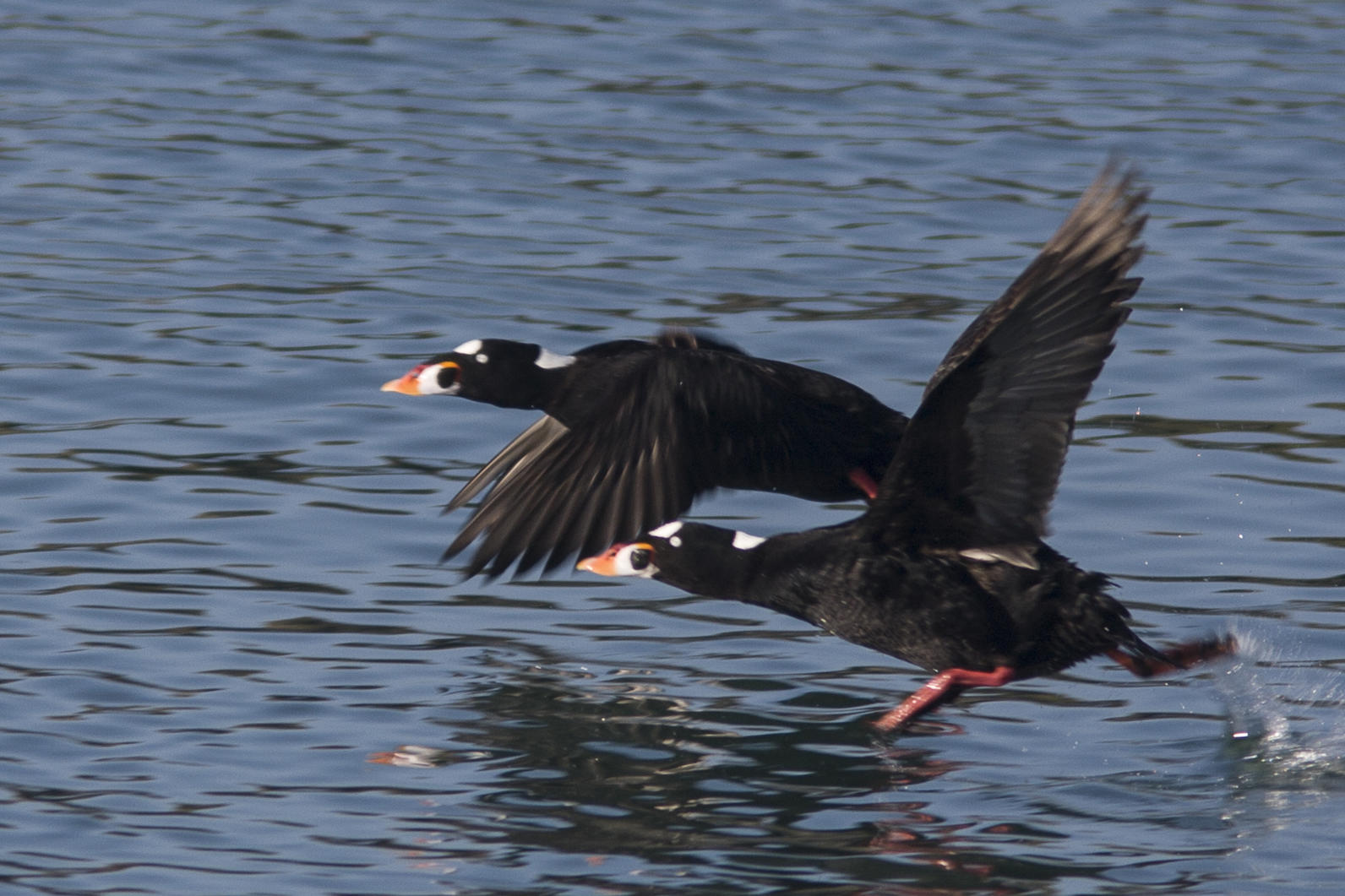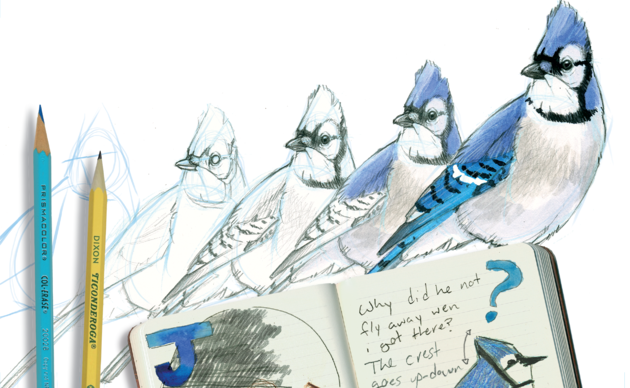Surf Scoter

Named for their propensity to forage in ocean surf, Surf Scoters (Melanitta perspicillata) are best known for the drake’s spectacular multicolored bill. Males have a white forehead patch, white nape patch and multicolored white, black, red, orange and yellow bill and white eye - creating a striking contrast with its all black body. Females are duller, with a mostly brown body and black bill, but are still recognizable by their heavily swollen bill and twin whitish patches on the sides of their head.
Forty to fifty percent of the Pacific Flyway’s Surf Scoter population is believed to overwinter in San Francisco Bay (Accurso 1992, Collins and Trost 2009, Pitkin and Wood (eds.) 2011, De La Cruz et al. 2014). Over the past 50 years, however, their populations have declined across their range by 50-60% (Sea Duck Joint Venture 2001) and lack of studies focused on the species’ breeding, migratory, and wintering ecology make conservation efforts a challenge.
Surf Scoters typically nest in northern boreal forests with shallow freshwater lakes, preferring lakes with little emergent vegetation or rocky-shored lakes and ponds (Décarie et al. 1995, Goudie et al. 1994, Savard and Lamothe 1991). Surf Scoters begin nesting upon arrival at breeding areas and males leave soon after eggs are laid. Nests are placed in dry brushy or forested areas (Palmer, 1976) and consist of a hollow in the ground lined with vegetative debris and down. While it is believed Surf Scoters are not well suited to walking on land, nests have been located 50m inland in dense scrub forest (Savard, et al. 1998).
The full extent of Surf Scoter’s breeding distribution in Alaska and Canada is likely underrepresented due to difficulties in detecting its presence, the low number of studies across its broad distribution, its secretive breeding behavior, and the difficulty in distinguishing between female Surf and White-winged scoters during surveys. Interestingly, USFWS Waterfowl population reports on breeding birds do not even include Surf Scoters in their reports due to difficulty in accurately surveying their populations.
Surf scoters generally winter in estuaries and shallow marine coastal waters (less than 10m), usually over pebbles and sand substrates (Goudie et al. 1994). They may also be abundant over rocky substrates and outnumber other scoters along steep rocky shores of fjords (Vermeer 1981). Surf Scoter wintering sites extend from the Aleutian Islands and south coast of Alaska to California and as far south as Baja California and the Gulf of California (Savard, 1998, Goudie et al 1994, Howell and Webb 1995).
Spring migration across the majority of Surf Scoter’s range begins in March. De La Cruz et al. (2009) suggest that coastal stopover or final staging areas may be of primary importance in supporting breeding success. The dynamics of the fall migration is poorly understood since males, females, and young likely have different migration routes and staging areas at this time of year, although across most of its range peak fall migration tends to occur mid to late October.
Audubon California's Richardson Bay Audubon Center & Sanctuary is addressing local conservation concerns through its new Waterbird Conservation Program. Currently, the Program is focused on nominating new San Francisco Bay Important Bird Areas (IBA) based on the concentration of Surf Scoters and other waterbirds. These new IBAs will help to focus conservation efforts--such as restoration or protections--in the areas where they can do the most good. We are also hosting an experiment by the US Geological Survey using rafts draped with kelp to attract spawning pacific herring; the eggs are known to be a significant source of food for Surf Scoters in winter.
Audubon California is also advocating for stronger protections for key forage fish species like pacific herring.
Threats & Conservation
- Predation: Common Loons occasionally prey on ducklings. Females with broods are quite disturbed by the presence of loons and have been observed decoying loons away from their young and leading their brood to shallow water when loons are nearby. Eagles are likely predators on molting, staging, and wintering areas. Mink, red fox, American Crow, Common Raven, and rats may be potential nest (egg) predators.
- Pollution: Heavy-metal contamination may affect overall body condition, reproductive success, and survival of Surf Scoters. Approximately fifty percent of North America’s Surf Scoters spend the winter in San Francisco Bay. Clams and mussels from the Bay have been found to have high concentrations of mercury, selenium, and cadmium that have entered the Bay from old mining runoff, irrigation drain water, and discharges from oil refineries. The exotic overbite clam, pervasive in San Francisco Bay, concentrates selenium at rates three times higher than native clams. A 1980s study determined that Surf Scoters wintering in the Bay had higher mercury and selenium concentrations than any other species of waterfowl (Hoffman et al. 1998). The impacts of lead, PCBs, DDE (Dichlorodiphenyldichloroethylene – a common product of the breakdown of DDT), Dioxins, Furan, and mercury have been inconclusive (Henny et al. 1991, 1995). Cadmium levels have been shown to be variable, but most individuals sampled from San Francisco Bay contained cadmium at levels indicating elevated chronic environmental exposure (Ohlendorf et al. 1986, 1991, Scheuhammer 1987). On both coasts, Surf Scoter are identified as one of the most vulnerable species to oil spills (King and Sanger 1979, Daigle and Darveau 1995).
- Disturbance: Boating, both motorized and non-motorized has been noted to cause flushing in Surf Scoter (Borgmann 2012), and while a few studies have linked disturbance to increased enegertic costs (Schummer and Eddleman. 2003; Korschgen 1985), the lasting effect of disturbance on Surf Scoter is undocumented.
- Climate Change: As mentioned earlier, a majority of the Surf Scoter population breeds in wetland areas surrounded by northern boreal forests. Changes to this habitat as a result of climate change could pose significant threats to the breeding population of Surf Scoter. Along the coasts and wintering habitats, climate change may alter prey species composition and herring spawn as well as alter subtidal habitat Surf Scoters depend on for foraging.
How you can help, right now
Get Audubon CA in Your Inbox
Our newsletter is fun way to get our latest stories and important conservation updates from across the state.
Donate to Audubon
Help secure the future for birds at risk from climate change, habitat loss and other threats. Your support will power our science, education, advocacy and on-the-ground conservation efforts.
HOTSPOT: Flyover of California's Birds and Biodiversity
California is a global biodiversity hotspots, with one of the greatest concentrations of living species on Earth.





